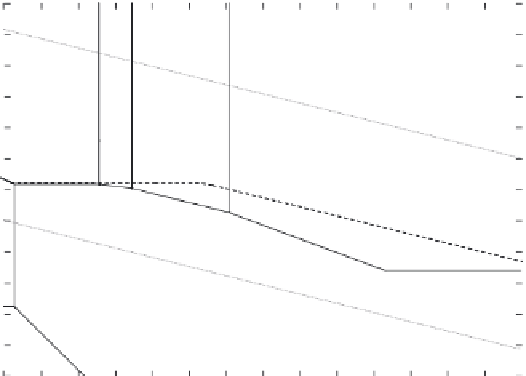Environmental Engineering Reference
In-Depth Information
1.4
1.2
1.0
0.8
0.6
0.4
UO
2
(+2a)
UO
2
(CO
3
)
3
(-4a)
0.2
0.0
-0.2
-0.4
-0.6
-0.8
-1.0
0
UO
2
U(+4a)
Fe (+2a)
Fe
U(+3a)
2
4
6
8
10
12
14
pH
FIGURE 9.5
pH-Eh diagram showing the stability fields of uranium species (c = 10
−6
mol/L) in different
oxidation stated in combination with stability filed of elemental iron, Fe
2+
and Fe
3+
(bold lines).
The dotted line indicates the stability field of U(VI)-hydroxo complexes in the absence of car-
bonate. (From Roine, A. 2007.
HSC Chemistry V.6.12
. Outotec Research Oy, Finland.)
distribute water inflow and outflow. The PRB is sealed with clay and geo-
synthetic clay liners at the bottom and with a geomembrane (high-density
polyethylene) at both sides and on the top. The design is displayed in Figure
9.6. The total mass of elemental iron installed as reactive material was 38 t,
from which 5 t was coarser material.
The pilot installation has yielded good removal results for uranium (99%)
and is still in operation. Table 9.2 lists average values for different parameters
for the operation period. It can be seen that the pH increased in the PRB by
almost 2 units, uranium concentration decreased by at least 95%, TDS was
halved and calcium was almost completely removed. The impact of precipi-
tates on the long-term performance of the installation will be investigated in
further research.
Monitoring data of the site over a period of 4500 days (12 years) is shown in
Figure 9.7. This includes data about the performance of the experimental PRB.
The removal mechanism of uranium in PRBs with elemental iron as reac-
tive material is discussed controversially (Fiedor et al. 1998, Gu et al. 1998,
Noubactep et al. 2003). Although reductive precipitation of U(VI) by elemen-
tal iron (see Reaction 9.4) is thermodynamically possible, evidence exists that
coprecipitation on aging iron corrosion products is the main removal mecha-
nism (Noubactep et al. 2006). On two DOE sites in the United States, U(VI)
was found the prevailing species after more than 1 or 3 years of operation
of a Fe
0
reactive barrier, respectively (Matheson et al. 2003). The presence



Search WWH ::

Custom Search